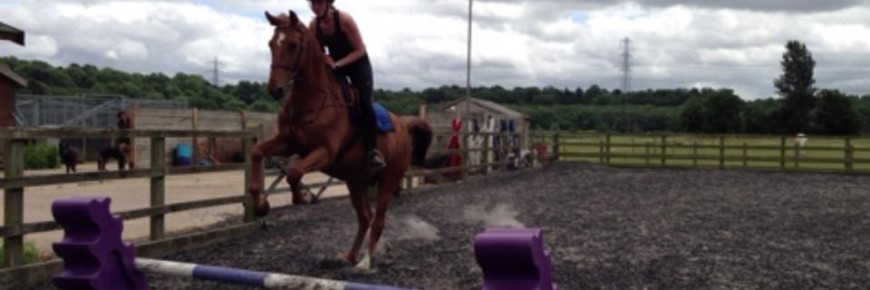
The primary element that unites a horse and rider with good performance is good posture! Put in simple terms, good posture is the secret to good riding. How can a horse be expected to have strong posture with an even gait if the rider it is carrying is un-level and unbalanced?
To maintain balance in the saddle, the rider needs sufficient core stability and strength to maintain good posture. Other factors that also limit control and stability and weaken the core muscles are reduced flexibility which in turn causes tight muscles and restricted movement through the joints, the result being that you are unable to adapt to the movements of the horse.
HOW CAN I TELL IF I HAVE POOR POSTURE?
When having a lesson, you may find that if you think back, you are always being told to correct the same things, “sit up taller” “bring your right hip back” “stop gripping with your knees”. If this is the case, having a simple postural assessment by a fitness professional or physiotherapist can inform you of any bio-mechanical weaknesses that you are exhibiting. Though this would be done off the horse, you can imagine how these are transferred and exaggerated when riding.
Common postural defects that we can exhibit are:
Unbalanced posture: uneven shoulders, uneven hips, head tilts to one side. Often the result of spending prolonged periods of time with your legs crossed, holding children on one hip or carrying unbalanced loads
Forward head posture: sometimes called readers neck, often the result of spending prolonged periods of time slumping at a computer, while driving, on the sofa or poor sleeping posture.
Lordosis/Swayback: forward tilt of the pelvis. Caused by imbalances in muscle strength.
Rounded shoulders: estimated to effect up to 73% of the population, commonly caused by slouching and fatigue.
Kyphosis: sometimes called hunched back. Commonly the result of degenerative conditions such as arthritis or by trauma.
Scoliosis: A persons spinal axis has a 3 dimensional deviation. Can be caused by abnormalities at birth, or by trauma.
WHAT EFFECT WILL THESE PROBLEMS HAVE ON MY RIDING PERFORMANCE?
Rounded Shoulders/Slumping/Kyphosis: Apart from having back, neck and shoulder pain. As a rider with this problem, your feet will likely move backwards, the thigh or knee may grip to compensate for lack of balance, the feet will be unstable in the stirrups as you grip with the thigh/knees and draw them up pulling the feet out of the stirrups. As a result, the horse will likely not move forward and be on the forehand
Lordosis/Swayback: As a rider you may be stiff through the arms and look quite rigid. You will have a lack of movement through the hips as a result of tight hipflexors, grip with your knees, rotate the toes outwards and find it difficult to keep the stirrups on the balls of the feet. As a result, the horse will have suppressed movement and hollow as a reflection of the rider.
Unbalanced Posture/Scoliosis: As a rider you may collapse through one hip, tilt the head to one side, you might find it easier to ride on one rein over the other, find it difficult to keep the stirrups on the balls of your feet, you might lose one stirrup more that the other and have a tendency to twist the body. The horse may reflect this by being prone to over bend.
HOW CAN I FIX THIS?
Depending on the issues you have with your posture and where your weaknesses lie, there are 4 main areas that you will need to work on.
1. Flexibility
2. Core Strength
3. Muscle Strength
4. Cardiovascular fitness
EXERCISE PRESCRIPTION
> Rounded Shoulders/Slumping/Kyphosis:
Weakness in the core, chest and upper back muscles, tightness in the hamstrings, glutes and lower back.
1. Flexibility: Focus on stretching the chest, hamstrings, glutes and lower back
2. Core Strength: Work on strengthening the glutes and abdominals, standing tall, ‘switching on’ your core and lengthening through the spine.
3 Muscle Strength: Build strength in the upper back (rhomboids, trapezius, latissimus dorsi, supraspinatus), chest and glutes.
4. Cardiovascular Fitness: The fitter you are, the longer it will take to fatigue. Muscles become fatigued due to an inadequate supply of oxygen. We get out of breath because it is our bodies innate response to increase oxygen uptake into the lungs. The fitter we are, the stronger our heart and lungs are and the more efficient we are at transporting oxygenated blood to the working muscles, thus delaying fatigue. When we are fatigued, we find it incredibly difficult to maintain good posture and thus technique.
> Lordosis/Swayback:
Weakness in the lower back, tightness in the hips and calves, feet tend to rotate out.
1. Flexibility: Focus on stretching the hip flexors, quadriceps and calves.
2. Core Strength: Work on strengthening the glutes and abdominals, standing tall, ‘switching on’ your core and lengthening through the spine.
3. Muscle Strength: Build strength in the lower back (erector spinae, latissimus dorsi and obliques).
4. Cardiovascular Fitness: (as above)
> Unbalanced Posture/Scoliosis:
Requires more in depth assessment to evaluate where the structural problem lies.
Flexibility: Spend time and work on stretching out the muscles on the side that is tighter.
Core Strength: Work on strengthening the glutes and abdominals, standing tall, ‘switching on’ your core and lengthening through the spine.
3. Muscle Strength: Build up strength and endurance in the muscles so that they are strong enough to hold the rider in a straighter more upright position.
4. Cardiovascular Fitness: (as above).
PREVENTION…
Is always better than cure! BUT, since we usually grow up and adapt our movement to accommodate these problems, it is not always possible.
By setting time aside to work on our overall flexibility and strength and by working on our posture we can attempt to counteract the effects that poor alignment and posture have on our body and technique not only in sport but through our everyday movement patterns.
